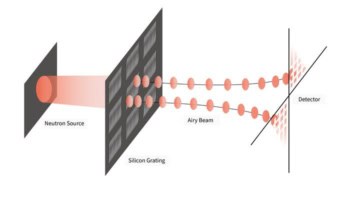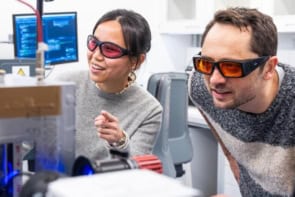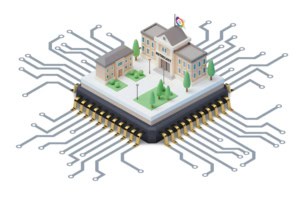Ling Xin reports on the construction of China’s first “super neutron microscope”

Amid the endless green lychee orchards near China’s southern coastline lies what will be a new science hub for the country’s researchers. Set to be complete in 2018, the China Spallation Neutron Source (CSNS), located some 30 km southeast of Dongguan, will be the nation’s first “super neutron microscope” to peer into the structure and dynamics of a wide range of materials from high-temperature superconductors and polymers to metals and biological samples.
Compared with other microscopic probes, neutrons have unique advantages by having no electric charge, being able to easily penetrate materials and being sensitive to light atoms such as hydrogen. Yet because of the technical complexity and high cost of building spallation sources, only three are in operation today: the Spallation Neutron Source (SNS) at the Oak Ridge National Laboratory in the US, the Materials and Life Science Experimental Facility (MLF) at the Japan Proton Accelerator Research Complex in Tokai, Japan, and the ISIS Neutron and Muon Source in Oxfordshire, UK. The European Spallation Source in Lund, Sweden, meanwhile, is currently under construction with first neutrons due in 2019.
Joining the prestigious club will be the CSNS, which was first proposed in the early 2000s. Five years later, the CSNS was top of a list of nine big-science facilities to be built in China. While most existing large science facilities are located around Beijing and Shanghai, the CSNS will be the first to be hosted in south China, with the aim to boost science in the region, which includes Hong Kong and Macau. Construction for the 2.2 billion RMB ($350m) CSNS began in 2012 and all civil-engineering work is set to be finished by the end of this year. Delivery of the first neutron beams is expected to start in September 2017.
While China currently has two research nuclear reactors that are used for neutron scattering – one in Beijing and one in Sichuan – it is spallation that will push the country to the forefront of neutron science. “If [China] is to have access to the highest performance neutron scattering in the future, which it presumably will do as a leading research nation, then spallation is the most sensible option,” says ISIS director Robert McGreevy.
A typical spallation neutron source consists of three parts: an accelerator, target and a suite of instruments. The CSNS will feature a 200 m-long linear accelerator that will accelerate negatively charged hydrogen ions to 80 MeV. The particles, stripped of their electrons and converted into protons, will then be injected into a 75 m-diameter circular accelerator – dubbed the rapid cycling proton ring – to be further accelerated to 1.6 GeV. Upon entering the target station, the high-energy proton beams will strike a set of 15 tungsten plates – each 25 × 10 cm in size – with every proton releasing some 20 to 30 neutrons.
Yuanbo Chen, head of the Dongguan Campus of the CAS Institute of High Energy Physics, and former deputy manager for the CSNS, says the proton target was a key aspect of the project and the team initially looked into having a liquid-mercury target that is currently employed on the SNS and the MLF. “We decided to adopt the tungsten target similar to ISIS,” adds Chen.
These fast neutrons will then be slowed by a liquid-hydrogen moderator before they can be guided to different instruments for experiments. The CSNS aims to produce neutron pulses with a beam power of 100 kW, with bunches of protons being released at a rate of 25 times per second – or 25 Hz. Initially, there will be only three general-purpose instruments – a multi-purpose reflectometer, a small-angle diffractometer and a high-intensity diffractometer. “We hope that more will keep coming in within the next few years,” says Chen.
Daoxin Yao, a condensed-matter physicist at Sun Yat-Sen University in Guangzhou, who is a prospective user of the CSNS, says it is unfortunate that more instruments will not be available from day one. In particular, he points out the lack of spectrometers, which can each cost around 10 million RMB. However, Hesheng Chen, CSNS project manager, says they have put in a proposal to the Chinese government to fund delivery of 12 to 13 spectrometers.
Industrial use
As well as being a boon for academia, the CSNS will also benefit industrial users. “As China is increasingly interested in driving innovation and moving beyond manufacturing technologies developed in other countries, having strong domestic R&D facilities oriented to the studies of materials will be an important national asset,” says SNS director Thom Mason.
Indeed, the money for some of the planned spectrometers, Yao suggests, should not just come from the government but from industry. He points to manufacturing and pharmaceutical companies, including industrial giants PetroChina, Sinopec and China Guangdong Nuclear Power Group, as companies that could have a good use for neutrons.
Although the facility will not be complete for another couple of years, researchers in China are already planning to upgrade the facility to generate a 500 kW beam power, which will be met by increasing the energy of the linear accelerator to about 250 MeV. This will be done using superconducting technology that is being developed by the Institute of High Energy Physics and other partner institutions.
Land has also been reserved for a second target station, which will produce neutron beams at a different frequency. This would be more suitable for experiments in the life sciences. “With more research emphasis on areas like biophysics, it would be good for the CSNS to have a low-frequency target station, which might be 5 or 10 Hz,” adds McGreevy.



